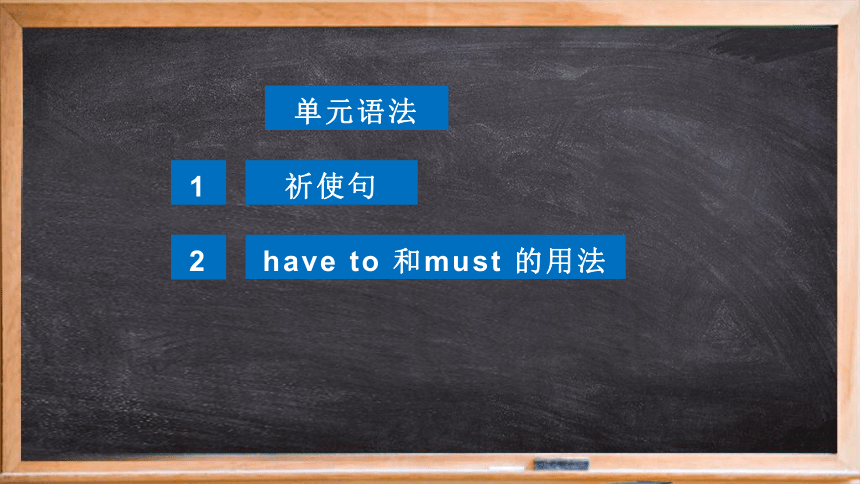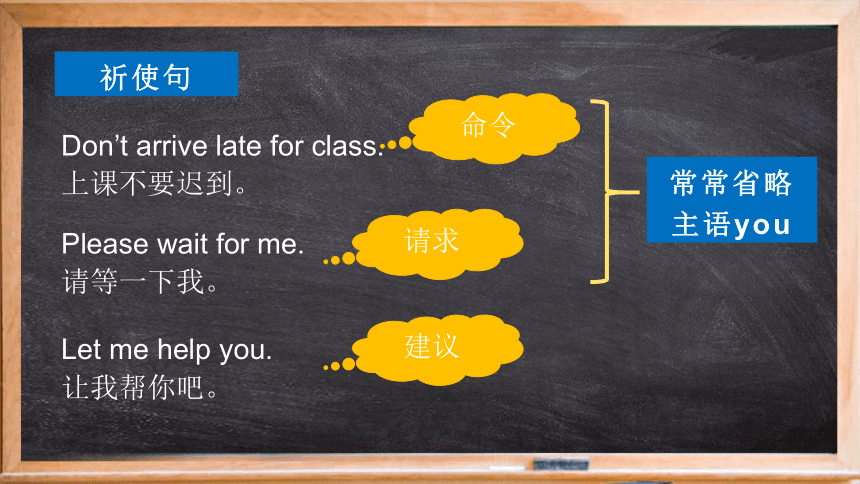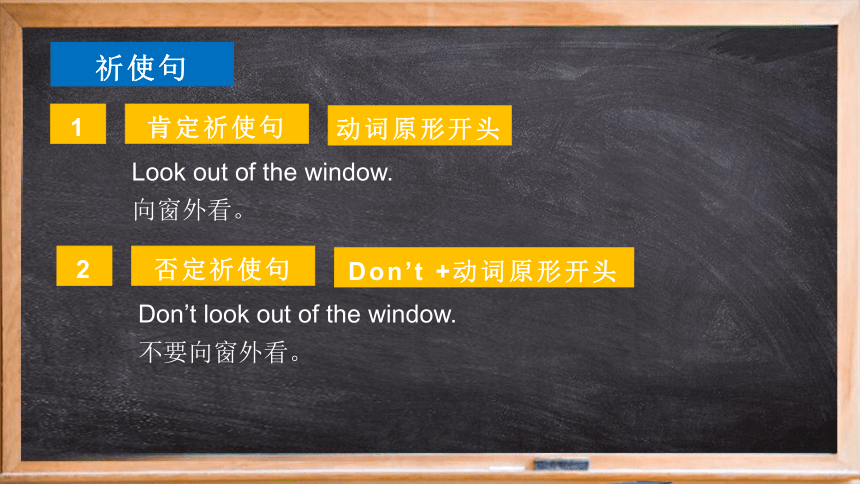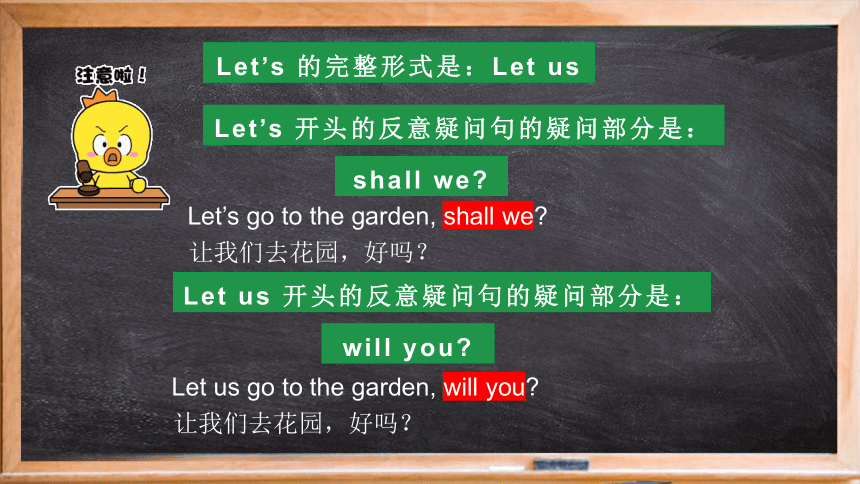人教版七年级Unit4单元语法专题课件
文档属性
| 名称 | 人教版七年级Unit4单元语法专题课件 |  | |
| 格式 | zip | ||
| 文件大小 | 4.1MB | ||
| 资源类型 | 试卷 | ||
| 版本资源 | 人教新目标(Go for it)版 | ||
| 科目 | 英语 | ||
| 更新时间 | 2023-04-09 17:39:05 | ||
图片预览







文档简介
(共19张PPT)
单元语法
1
祈使句
2
have to 和must 的用法
一.祈使句
什么叫祈使句?
祈使句用来表示请求,命令或建议。
祈使句
Don’t arrive late for class.
上课不要迟到。
命令
Please wait for me.
请等一下我。
请求
Let me help you.
让我帮你吧。
建议
常常省略
主语you
祈使句
1
肯定祈使句
动词原形开头
Look out of the window.
向窗外看。
2
否定祈使句
Don’t +动词原形开头
Don’t look out of the window.
不要向窗外看。
3
let引导的祈使句
肯定:Let sb. +动词原形
Let me help you.
让我帮你吧。
否定:Don’t let sb. +动词原形
Don’t let him help you.
别让他帮你。
let sb. not +动词原形
Let him not go.
让他别走。
Let’s 的完整形式是:Let us
Let’s 开头的反意疑问句的疑问部分是:
shall we
让我们去花园,好吗?
Let us 开头的反意疑问句的疑问部分是:
will you
让我们去花园,好吗?
4
No+动ing/名词开头的祈使句
通常用在标识语
No swimming!
禁止游泳!
No photos!
禁止拍照!
小结
祈使句
定义
用来表示请求,命令或建议
类型
肯定祈使句
动词原形开头
否定祈使句
Don’t + 动词原形开头
let祈使句
肯定
否定
Let sb.+动原
Don’t let sb.+动原
No+动ing/名词祈使句
通常用在标识语
巩固练习:
用括号内所给单词的适当形式填空。
1. _____________ (do) your homework right now(立刻).
2. Please _____________ (be) quiet.
3. _____________ (not let) the dog come in.
4. No _____________ (swim)!
5. Stop _____________ (talk)!
Do
Be
Don’t let
swimming
talking
根据汉语意思完成句子,每空一词。
1. 到这儿来。 ______ _____.
2. 别让他们玩电脑游戏。
_______ _____ ________ ________ computer games.
3. 快点! ________ quick!
4. 不要在这儿吃东西。_______ _______ here.
5. 让我们骑自行车到那儿吧。
_______ _________ the bike to get there.
6. 别在走廊里跑。 ____________ _____________ in the hallways.
Come
here
Don’t
let
them
play
Be
Don’t
eat
Let’s
ride
Don’t
run
二. have to和must 的用法
have to
表示客观上的“不得不”
We have to be quiet in the library.
我们在图书馆必须安静。
We have to wear the uniforms at school.
我们在学校必须穿校服。
第三人称单数用:has to
She has to help her mother with the housework.
她必须要帮她妈做家务。
否定形式:don’t have to
We don’t have to wear the school uniforms.
我们不必穿校服。
否定形式:第三人称单数用doesn’t have to
She doesn’t have to go home by 10 o’clock.
她不必10点钟之前回家。
must
表示主观上的“必须”
We must be on time for class.
我们上课必须要准时。
I must do my homework in the evening.
我晚上必须要写作业。
must 开头的问句
肯定回答用:must
否定回答用:need’t 或don’t have to
Mom, must I go home by 10 o’clock
妈妈,我10点钟之前必须要回家吗?
肯定回答:Yes, you must.
否定回答:No, you needn’t.
No, you don’t have to.
must 的否定形式 mustn’t
表示:一定不要;禁止
We mustn’t use mobile phones when the plane takes off
飞机起飞时乘客禁止使用手机。
小结
have to
must
表示客观上的“不得不”
表示主观上的“必须”
原形:have to
三单:has to
否定:don’t/ doesn’t have to
请根据你校的实际情况,用have to,don’t have to,can,can’t,must,mustn’t等表达你的校规。
1. I _____________ arrive late for class. I _____________ be on time.
2. I _____________ keep my hair short and wear a school uniform.
3. I _____________ listen to my teachers carefully in class. I _____________ talk with my partner.
4. I _____________ be noisy in the classroom. I _ ____________ be quiet.
5. I _____________ eat in the classroom. I _____________ eat in the dining hall.
can’t
must
have to
mustn’t
mustn’t
mustn’t
must
can’t
must
Thank you
单元语法
1
祈使句
2
have to 和must 的用法
一.祈使句
什么叫祈使句?
祈使句用来表示请求,命令或建议。
祈使句
Don’t arrive late for class.
上课不要迟到。
命令
Please wait for me.
请等一下我。
请求
Let me help you.
让我帮你吧。
建议
常常省略
主语you
祈使句
1
肯定祈使句
动词原形开头
Look out of the window.
向窗外看。
2
否定祈使句
Don’t +动词原形开头
Don’t look out of the window.
不要向窗外看。
3
let引导的祈使句
肯定:Let sb. +动词原形
Let me help you.
让我帮你吧。
否定:Don’t let sb. +动词原形
Don’t let him help you.
别让他帮你。
let sb. not +动词原形
Let him not go.
让他别走。
Let’s 的完整形式是:Let us
Let’s 开头的反意疑问句的疑问部分是:
shall we
让我们去花园,好吗?
Let us 开头的反意疑问句的疑问部分是:
will you
让我们去花园,好吗?
4
No+动ing/名词开头的祈使句
通常用在标识语
No swimming!
禁止游泳!
No photos!
禁止拍照!
小结
祈使句
定义
用来表示请求,命令或建议
类型
肯定祈使句
动词原形开头
否定祈使句
Don’t + 动词原形开头
let祈使句
肯定
否定
Let sb.+动原
Don’t let sb.+动原
No+动ing/名词祈使句
通常用在标识语
巩固练习:
用括号内所给单词的适当形式填空。
1. _____________ (do) your homework right now(立刻).
2. Please _____________ (be) quiet.
3. _____________ (not let) the dog come in.
4. No _____________ (swim)!
5. Stop _____________ (talk)!
Do
Be
Don’t let
swimming
talking
根据汉语意思完成句子,每空一词。
1. 到这儿来。 ______ _____.
2. 别让他们玩电脑游戏。
_______ _____ ________ ________ computer games.
3. 快点! ________ quick!
4. 不要在这儿吃东西。_______ _______ here.
5. 让我们骑自行车到那儿吧。
_______ _________ the bike to get there.
6. 别在走廊里跑。 ____________ _____________ in the hallways.
Come
here
Don’t
let
them
play
Be
Don’t
eat
Let’s
ride
Don’t
run
二. have to和must 的用法
have to
表示客观上的“不得不”
We have to be quiet in the library.
我们在图书馆必须安静。
We have to wear the uniforms at school.
我们在学校必须穿校服。
第三人称单数用:has to
She has to help her mother with the housework.
她必须要帮她妈做家务。
否定形式:don’t have to
We don’t have to wear the school uniforms.
我们不必穿校服。
否定形式:第三人称单数用doesn’t have to
She doesn’t have to go home by 10 o’clock.
她不必10点钟之前回家。
must
表示主观上的“必须”
We must be on time for class.
我们上课必须要准时。
I must do my homework in the evening.
我晚上必须要写作业。
must 开头的问句
肯定回答用:must
否定回答用:need’t 或don’t have to
Mom, must I go home by 10 o’clock
妈妈,我10点钟之前必须要回家吗?
肯定回答:Yes, you must.
否定回答:No, you needn’t.
No, you don’t have to.
must 的否定形式 mustn’t
表示:一定不要;禁止
We mustn’t use mobile phones when the plane takes off
飞机起飞时乘客禁止使用手机。
小结
have to
must
表示客观上的“不得不”
表示主观上的“必须”
原形:have to
三单:has to
否定:don’t/ doesn’t have to
请根据你校的实际情况,用have to,don’t have to,can,can’t,must,mustn’t等表达你的校规。
1. I _____________ arrive late for class. I _____________ be on time.
2. I _____________ keep my hair short and wear a school uniform.
3. I _____________ listen to my teachers carefully in class. I _____________ talk with my partner.
4. I _____________ be noisy in the classroom. I _ ____________ be quiet.
5. I _____________ eat in the classroom. I _____________ eat in the dining hall.
can’t
must
have to
mustn’t
mustn’t
mustn’t
must
can’t
must
Thank you
同课章节目录
- Unit 1 Can you play the guitar?
- Section A
- Section B
- Unit 2 What time do you go to school?
- Section A
- Section B
- Unit 3 How do you get to school?
- Section A
- Section B
- Unit 4 Don't eat in class.
- Section A
- Section B
- Unit 5 Why do you like pandas?
- Section A
- Section B
- Unit 6 I'm watching TV.
- Section A
- Section B
- Review of Units 1-6
- Unit 7 It's raining!
- Section A
- Section B
- Unit 8 Is there a post office near here?
- Section A
- Section B
- Unit 9 What does he look like?
- Section A
- Section B
- Unit 10 I'd like some noodles.
- Section A
- Section B
- Unit 11 How was your school trip?
- Section A
- Section B
- Unit 12 What did you do last weekend?
- Section A
- Section B
